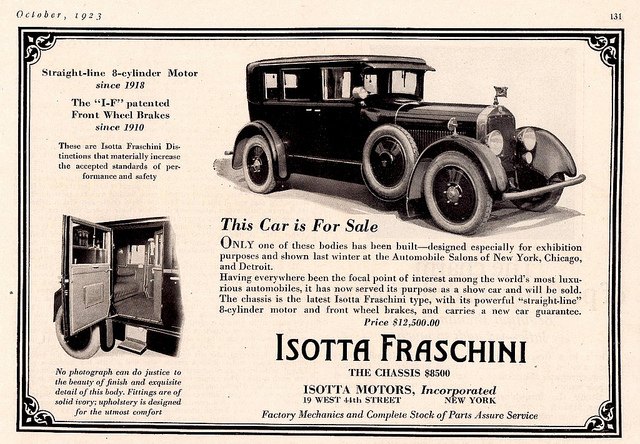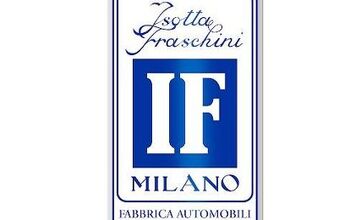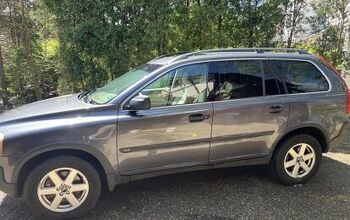Rare Rides Icons: Isotta Fraschini, Planes, Boats, and Luxury Automobiles (Part II)

Isotta Fraschini never intended to build its own cars and was founded as an Italian-based importer of French vehicles and engines. But as we learned in Part I, after a few years in the business its small group of owners experimented with building their own cars. Then they tried their hand at winning races with Tipo D in 1905. After D’s successor the Tipo FE was unsuccessful at racing, the company redirected itself and decided to make sporting luxury cars instead. We pick up the action in a year many of you remember vividly: 1910.
The first car to pursue IF’s new ethos was the Tipo KM. A luxury touring car, the KM wore IF badges on both sides of its very pointed grille. First shown to the world via Paris in 1910, the KM was immediately impressive given its technical specifications. Isotta Fraschini put their experience and knowledge from both prior race cars to good use in the KM. Like the Tipo D, it had a massive displacement inline-four engine, a whopping 10.6 liters. Said engine used technology employed in the FE race car, as the I4 was an overhead cam design. Power was transferred to the rear wheels via a chain drive. Said chain needed to be a very strong one, as in 1910 the KM was one of the most powerful cars in the world.
Its engine was available in two specifications – one for the European market, and one for America. European spec cars produced 120 horsepower and reached a top speed of nearly 81 miles per hour. Examples of the KM sent to America had 140 horsepower, which meant a higher top speed of 99 miles per hour. These were incredibly impressive figures for 1910. Consider a Cadillac Model Thirty roadster made 33 horsepower from its inline-four and had a top speed of 60 miles per hour.
Fittingly for the KM’s considerable performance, it employed a brand new stopping technology in the form of brakes at all four wheels. Four-wheel brakes were invented in Scotland in 1909 by car manufacturer Arrol-Johnston, who produced the first automobile in Britain in 1895. (We’ll have some coverage of Arrol-Johnston in this series, too.) IF used the Arrol-Johnston system and developed it a bit further: Founder Oreste Fraschini created a mechanism for the brakes to allow the use of front or rear brakes individually. IF was one of the first companies to employ four-wheel brakes on a production car.
The Tipo KM was instantly in demand among the wealthy given its performance, and IF specifically targeted America as a sales outlet. Early in the 1910s, Isotta Fraschini established a dealership in New York City, and sold its single model to impressed affluent urbanites. The KM remained in production through 1914, but in 1913 gained additional fame when race driver Ray Gilhooley (1887-1973) took it around the Indianapolis Brickyard in stock form. The KM had its four-door body, a windshield, all its panels and spare tires, and four people in the cabin. It lapped the oval in 1 minute 52 seconds, or six seconds faster than the average time of the winner of that year’s 500. At the end of its five-year run, 50 total KMs were built. Isotta Fraschini took a short hiatus from car building while World War I raged. IF had another business concern by then, as it produced a few airplane engines. That business continued, as IF built engines like the L. 180, an inverted W-18 design.
The company’s next car arrived in 1919 and was a landmark. It was called the Tipo 8 and debuted at the Paris Auto Salon of 1919. The 8 was much larger than the KM and was the first car in the world to employ an inline-eight engine. The straight-eight was 5.9 liters in displacement, and used overhead valves but lacked an overhead cam. Like the KM, there was 100 horsepower on tap. The transmission was initially a three-speed manual but swapped over to a four-speed later in its run. One wheelbase was offered by IF, at 145.6 inches.
Deliveries to customers began in 1920, as the Tipo 8 was the first car Isotta Fraschini built in any considerable number. The Tipo 8 changed IF’s approach to car building, as it became a provider of a chassis and running gear, and left the bodywork to coachbuilders. That’s what high-end customers wanted anyway. The Tipo 8 was bodied by Cesara Sala and Carrozzeria Castagna primarily, but other companies produced bodies for the 8 in Europe, and the list included LeBaron in the United States. Two- and four-door versions were available, though the two-door was less common. Wealthy people around the world placed the Tipo 8 on the same plane as Rolls-Royce. Isotta Fraschini had made it. The company was living large in America at the time, where in October of 1923 the Tipo 8 asked $12,500, or $200,000 adjusted for inflation. Tipo 8 was made through 1924, and 1,380 were built in total. Quite a step up from the KM’s 50 cars in five years.
Tipo 8 was immediately succeeded by the Tipo 8A in 1924. The 8A rode on the same wheelbase as the Tipo 8, but IF now offered a sportier S/SS version with a chopped 134-inch wheelbase. Under the very long hood was a larger straight-eight than before, at 7.3 liters displacement. The overhead valves were joined by the company’s favorite pastime, an overhead cam. Bigger displacement meant more horsepower, as figures ranged from 115 to 160 horses depending on tune. During its run through 1931, the 8A held claim to the most powerful inline-eight engine in the world. Isotta Fraschini claimed without concern that all their cars could do 93 miles per hour.
The company’s fortunes continued to climb, and by 1928 IF had an additional showroom in Chicago. A third of the Tipo 8A’s sales were to Americans. Early film stars like Rudy Valentino and Clara Bow drove Isotta Fraschinis. Toward the end of its run, the 8A commanded more money than even the Duesenberg Model J. Of course, extremely expensive cars tend not to sell as well during events like The Great Depression, which arrived in August 1929. That put a dent in the production figures, and at the end of the 8A’s life in 1931 the total count was 950.
The Depression was still ongoing when Isotta Fraschini debuted its next extremely expensive luxury car, which might not have been the best use of money in hindsight. More on that in Part III.
[Images: Isotta Fraschini, YouTube]

Interested in lots of cars and their various historical contexts. Started writing articles for TTAC in late 2016, when my first posts were QOTDs. From there I started a few new series like Rare Rides, Buy/Drive/Burn, Abandoned History, and most recently Rare Rides Icons. Operating from a home base in Cincinnati, Ohio, a relative auto journalist dead zone. Many of my articles are prompted by something I'll see on social media that sparks my interest and causes me to research. Finding articles and information from the early days of the internet and beyond that covers the little details lost to time: trim packages, color and wheel choices, interior fabrics. Beyond those, I'm fascinated by automotive industry experiments, both failures and successes. Lately I've taken an interest in AI, and generating "what if" type images for car models long dead. Reincarnating a modern Toyota Paseo, Lincoln Mark IX, or Isuzu Trooper through a text prompt is fun. Fun to post them on Twitter too, and watch people overreact. To that end, the social media I use most is Twitter, @CoreyLewis86. I also contribute pieces for Forbes Wheels and Forbes Home.
More by Corey Lewis
Latest Car Reviews
Read moreLatest Product Reviews
Read moreRecent Comments
- Lou_BC Well, I'd be impressed if this was in a ZR2. LOL
- Lou_BC This is my shocked face 😲 Hope formatting doesn't fook this up LOL
- Lou_BC Junior? Would that be a Beta Romeo?
- Lou_BC Gotta fix that formatting problem. What a pile of bullsh!t. Are longer posts costing TTAC money? FOOK
- Lou_BC 1.Honda: 6,334,825 vehicles potentially affected2.Ford: 6,152,6143.Kia America: 3,110,4474.Chrysler: 2,732,3985.General Motors: 2,021,0336.Nissan North America: 1,804,4437.Mercedes-Benz USA: 478,1738.Volkswagen Group of America: 453,7639.BMW of North America: 340,24910.Daimler Trucks North America: 261,959





































Comments
Join the conversation
Sexy beast.
The 8A was the car Norma Desmond was driven in in “Sunset Boulevard”.